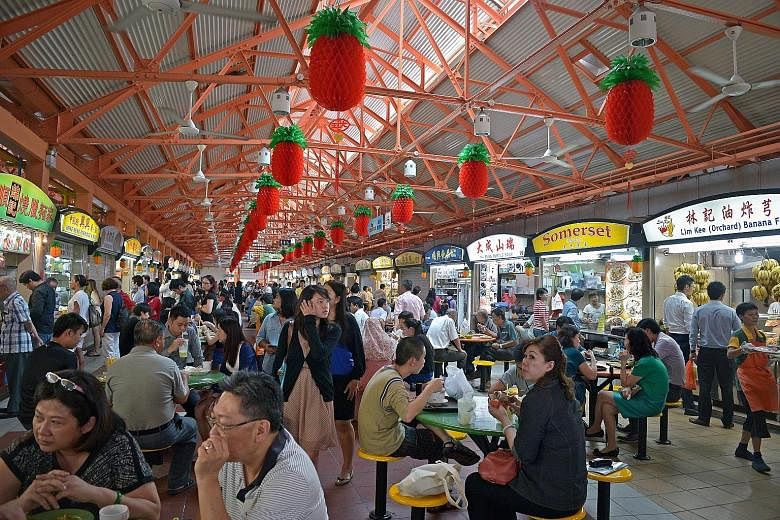The announcement on Monday that Singapore will be getting its own Michelin Guide next year was greeted with elation, scepticism and worry.
The guide, an offshoot of French tyre company Michelin, was launched in 1900 in a bid to increase the sale of cars and, therefore, tyres by showing French motorists where they could go for good food. It has since spawned 25 guides covering 24 countries.
Despite the controversies over how the restaurants are assessed and rumblings about how it is out of touch with what's really happening in the food world, the guide has become something of a bible for those wanting to know where to eat well. People trust it because the inspectors dine anonymously and always pay for their meals, both of which go some way in ensuring that the Michelin ratings, of one to three "stars", cannot be bought.
The elation is coming mostly from chefs and restaurateurs. For the latter, a star rating will almost guarantee increased business.
Chefs here can finally be ranked with the best in the world.

As chef Andre Chiang, 39, of Restaurant Andre in Bukit Pasoh Road, who worked for years in Michelin-starred restaurants in France, said in a Facebook post: "Since the first day Restaurant Andre opened its doors in 2010, every day, every service, every dish, we put our whole heart in it, we don't 'get ready', we 'stay ready'."
Diners, on the other hand, are the ones who worry and are sceptical.
They wonder if the inspectors are up to the job.
Mr Michael Ellis, 53, international director of the Michelin Guides, has said that fine dining establishments are not the only ones that will be assessed. The inspectors will be looking at the entire dining scene here, including hawker food.
As he tells The Straits Times: "Given the huge diversity and quality of the hawker food market, I would be very surprised that hawker food does not play an important part in the Singapore guide.
"If they find hawker food with the quality, consistency and ingredients to earn a star, it'll happen. We gave a star in Hong Kong for dim sum at Tim Ho Wan, showing that it's possible."
For any city's debut guide, the inspectors doing the assessment are drawn from Michelin's pool from all over the world. Mr Ellis says they are all experienced, having eaten widely and been exposed to street food and such.
In subsequent years, local inspectors will be hired and trained to supplement those from overseas.
But can someone who did not grow up eating kway chap - sheets of rice noodles in a thick broth eaten with offal - really assess it fairly? Will they understand the nuances of white on white chicken rice? Can they tell different styles of bak chor mee (minced pork noodle) apart? Will they understand our soul food?
There are others who worry about prices going up.
But, in fact, restaurateurs here have had no problems charging high prices, Michelin Guide or not. I have paid more for meals here than I have at Michelin-starred elBulli in Spain and The French Laundry in the United States.
Food operators know they risk alienating diners with every price hike. This is especially so for hawker food, where a 10-cent increase can drive business to other stalls.
I trust savvy hawkers and restaurateurs will know what to do. If the prices become even more ridiculous than they are now, diners will walk. There are plenty of choices here for hungry people.
Now, I have never relied on guides or lists of best restaurants in the world to decide where to eat. I don't even read reviews if I can help it. Instead, I read up on the chefs, check out their cookbooks, if they have any, watch documentaries on them, talk to friends who have dined at the restaurants and then decide.
But I know there are many others who do rely on guides and I can see at least three good things that will come out of a Michelin one for Singapore.
The first is that local talent will be given a platform to shine if they do well and impress the inspectors. I hope the inspectors are as thorough as Mr Ellis implies they will be.
Wouldn't it be wonderful if chefs Bryan Chia and Petrina Loh, both 33, of Morsels in Mayo Street; Jason Tan, 33, of Corner House in the Botanic Gardens; Brandon Foo, 29, of Le Bistrot Du Sommelier in Armenian Street; and Anthony Yeoh, 34, of Cocotte in Dickson Road are recognised in the guide?
There is also Willin Low, 43, who started serving Modern Singapore cuisine at his restaurant Wild Rocket in Mount Emily, encouraging other chefs to give familiar dishes a sophisticated twist.
The second is that the Singapore dining scene will get a boost from having a Michelin Guide, with more people travelling here to dine and, hopefully, discovering the city's other charms at the same time.
I have said it before, but it bears repeating: Any initiative to promote Singapore on the world stage is not to be sniffed at. The economic outlook seems gloomy, so getting more travellers here willing to spend money can only be a good thing.
The third silver lining is a wish that I hope will become reality.
Consistency, more precisely the lack of it, is a problem that plagues all levels of the food scene here. The food in a hawker stall, cafe, zi char place or high-end restaurant can be great one time and not so great or downright terrible on the next visit.
The usual reason for this problem - difficulty in hiring and retaining staff - will not go away any time soon. So restaurants will have to buck up and find other ways to ensure the quality stays the same.
Mr Ellis has said the inspectors visit the same restaurant two, three times, months apart, and consistency is one criterion.
Any chef or hawker who wants to stay on the guide or to get more stars will have to work harder at consistency.
They will not be able to rely on a couple of signature dishes to impress but will be forced to create, to think through the sequence of a meal, to source ingredients more carefully, and do everything possible to ensure their establishments stand out.
I hope my wish for consistent, quality fare will come true, and I will not be throwing good money at bad food as often as I do now.
Ultimately, the success of the guide will depend not just on the quality of the restaurants here, but also on the credibility of the guide.
If it goes the way of the Hong Kong and Macau one, then all that hard work by chefs and hawkers here will have been for nothing.
When the first edition of the Hong Kong and Macau guide was published in 2008, people complained that it focused too much on high-end restaurants.
In subsequent years, they have been mystified by the restaurants awarded stars. Those that are pretty good but not the best have been given the top rating of three stars. One Chinese restaurant came out of nowhere to get three stars in the 2011 third edition of the guide. This, apparently, had never happened before - anywhere.
Like many other people who are into food, I cannot wait for the first edition of the Singapore Michelin guide to come out, some time in the second half of next year.
We Singapore eaters are a passionate, vocal lot - and we will not be afraid to pounce.


